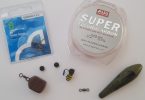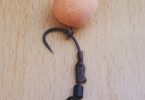A hair-rigged boilie is now certainly the most common bait of modern day carp anglers.
Hair-rigs were devised to fool carp who had become wary of the side-hooked boilie, pictured below.
Hair-rigging also greatly impoves bait presentation, for not only boilies but for other particle baits, including pellets and naturals.
How do I do it?
Most hair rigs are tied via a knotless knot, and this method of tying hairs has always proven strong enough for me. Finish off the other end of the rig with a swivel of appropriate size. I usually prefer to use braid for my Hair-rig hooklengths, due to its extra suppleness and strength for it’s diameter.
Why does it work?
As explained above, hair-rigged baits give better presentation, crucial for tempting those larger carp to bite. When carp feed, they will mouth baits and then eject them. Hair-rigged baits leave the hook free to prick in the carp’s mouth upon rejection of the bait, causing carp to bolt and signalling runs. As most carp anglers fish with tight lines to bite alarms, getting the carp to bolt to signal a run is vital. Following this text is Chris Shaw’s explanation of how he prefers to use the basic hair rig.
From Chris Shaw : The hair rig is the basic type whereupon the hair is a length 1/2lb – 1lb nylon about 1/2 – 2 inches in lengthand the hooklength can be either nylon or braid of about 12 – 16 inches. Hook size 10 – 8 for a 16 – 18mm boilie, I would not go bigger but then I suppose it would dependent on the size of the fish that you expect to catch. I have caught carp to 25 on the size tens, A friend of mine has seen carp to 30 landed on size tens as well.










